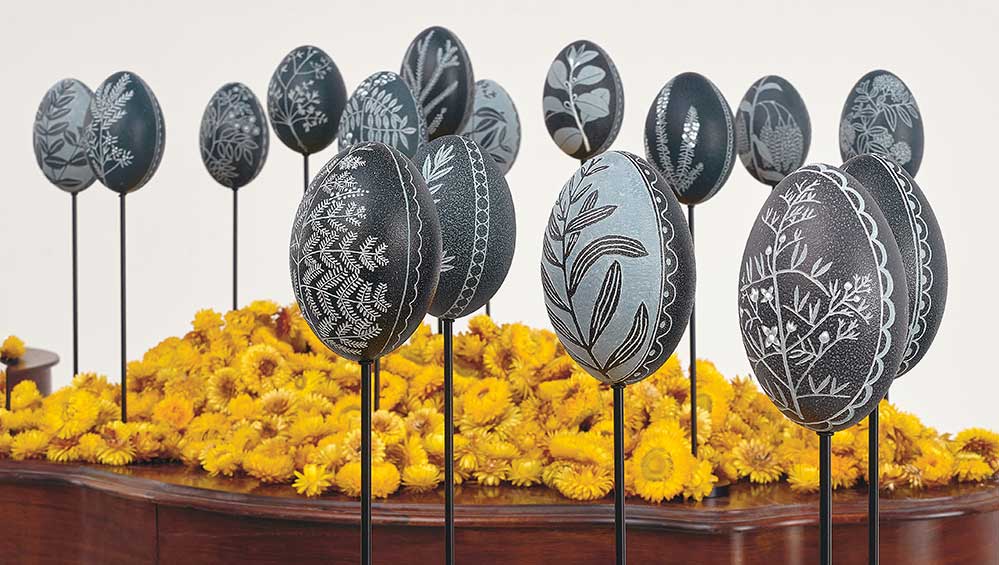
Jonathan Jones. Untitled (emu eggs) after Étienne-Pierre Ventenat, 2021–23. Emu (Dromaius novaehollandiae) eggshell, powder-coated steel, golden everlasting paperdaisy (Xerochrysum bracteatum) flowers, dimensions variable. Courtesy the artist. Photo: Jenni Carter.
Artspace, Sydney
15 December 2023 – 11 February 2024
by JANET McKENZIE
The inaugural exhibition at Artspace, Sydney, following the extensive refurbishment of its new home at the Gunnery warehouse, is by Wiradyuri and Kamilaroi artist Jonathan Jones (b1978). A collaboration with Palais de Tokyo, Paris, the Sydney iteration runs until next month, when it will tour four more venues in Australia. Jonathan Jones: Untitled (Transcriptions of Country) explores colonial transport, trade and the acclimatisation of Indigenous plants, animals and objects as well as the colonisation of local knowledge. His art rewrites history.
Arriving in Australia for the first time in 18 months, I was excited at the prospect of seeing art of this calibre, the product of years of research and preparation. Australian Aboriginal art is unique, representing a continuous living culture for more than 60,000 years. Indigenous art has played a powerful role in the campaign for Land Rights since the 1970s.
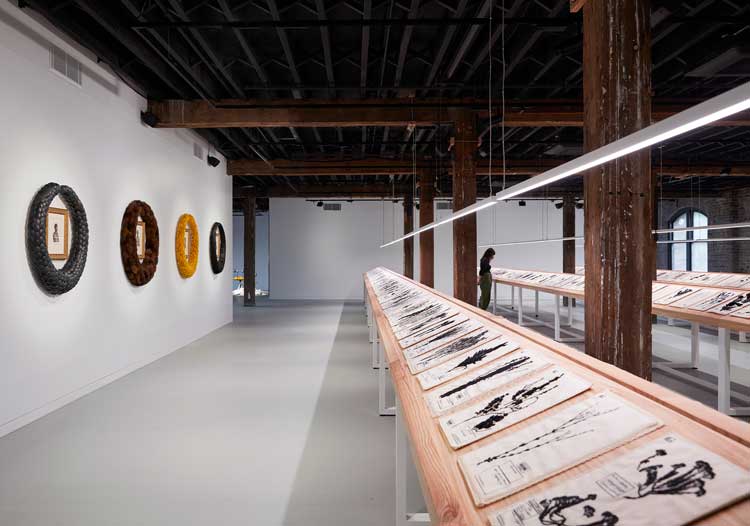
Jonathan Jones. Untitled (transcriptions of country), 2023. Installation view, Artspace, Sydney. Photo: Zan Wimberley.
A recent event of great import in Australia was the referendum on 14 October 2023 on whether to change the constitution to recognise the First Peoples of Australia by establishing a body called the Aboriginal and Torres Strait Islander Voice. The Australian electorate voted against the change. How was it possible to embrace the exemplary work of one of Australia’s leading First Nations people, who seeks to rewrite the history of colonial Australia, when the Australian people had voted overwhelmingly against the Indigenous population having a voice in parliament? Was the art world out of step with the wider nation?
I was introduced to Jones’s work following the inclusion of his spectacular Untitled (Giran) at the Asia Pacific Triennial in 2019. I was shown dozens of images by Billy Gartley, head of cultural services at Leisure & Culture Dundee, Scotland, who had just returned from Australia. The installation, which included 2,000 separate sculptures, had been described by the artist as a murmuration of winged sculptures. Even just seeing it as a photograph on a small screen, I experienced the power and energy of a work that alluded to birds in flight, made by hand using hundreds of feathers and bones and installed along a vast wall. Murun is a Wiradjuri word meaning breath or life; the English word “murmur” describes a low recurring sound, or soft voices. Creating a new word from two dichotomous cultures exemplifies the creative practice of one of Australia’s most inventive and prolific artists.
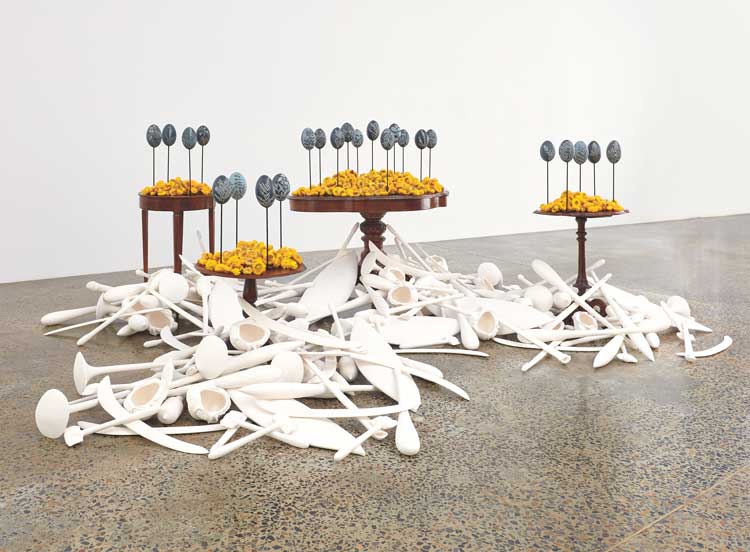
Jonathan Jones. Untitled (emu eggs) after Étienne-Pierre Ventenat, 2021–23, and untitled (vases, armes, pêche), 2023. Emu (Dromaius novaehollandiae) eggshell, powder-coated steel, golden everlasting paperdaisy (Xerochrysum bracteatum) flowers, antique tables; earthenware, 206 pieces, dimensions variable. Ceramic work: Somchai Charoen. Courtesy the artists. Photo: Jenni Carter.
This latest show, Untitled (Transcriptions of Country), initially struck me as a research-based conceptual project, in contrast to the expressiveness of Untitled (Giran). It presents a unique interpretation of a vast body of research material collected on one of the most extensive scientific expeditions to Australia, commissioned by Napoleon Bonaparte, under the command of Captain Nicolas Baudin in 1800-03. The expedition returned to France with great volumes of living plants and animals along with Aboriginal artefacts.
The expedition provides an alternative to the British narrative of Australian history because Baudin’s attitude to Aboriginality was quite different from that of the British, influenced as it was by the French Revolution that espoused equality. Baudin wrote one of the first Land Rights letters recognising that the Aboriginal people were in possession of the land and that Europeans had no right to claim it.
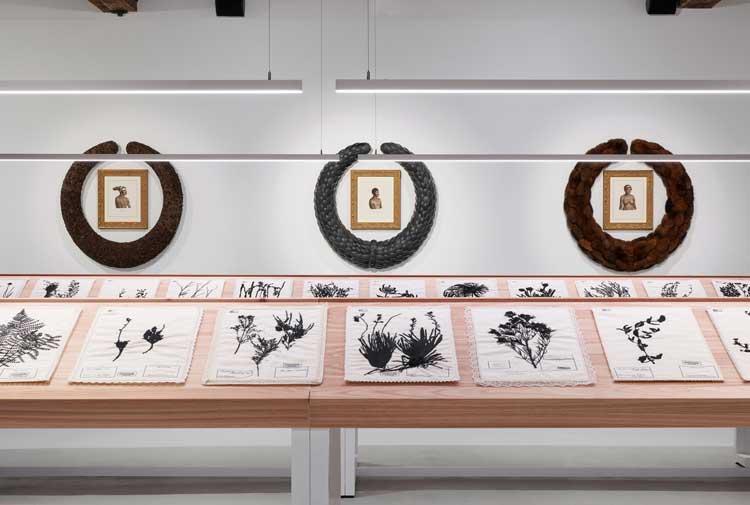
Jonathan Jones. Untitled (transcriptions of country), 2023. Installation view, Artspace, Sydney. Photo: Zan Wimberley.
Jones has experience working in numerous disciplines, including architecture, archaeology, biology and linguistics, alongside his visual art practice. His formal inventiveness results in installations and artworks ranging in style and formal qualities. On a project as wide-ranging as this, Jones works collaboratively. When he was working on Untitled (Giran), he was inundated with feathers after appealing to his community to supply them, as well as kangaroo bones and handmade string from his Wiradjuri people. The practical advantages and support network aside, Jones emphasises that, as an Indigenous artist, he has a responsibility to work with the community and to give something back.
Transcriptions of Country has an aesthetic that is distinct from the Australian Aboriginal art movement Papunya Tula, which was born in the early 1970s in the Central Desert and is now well known around the world. Until recently, much less attention has been paid to the Aboriginal culture of the south-east of Australia. Working closely with linguists and elders, Jones aims to regenerate stories, questioning the continuing impact of colonialism. He also asserts the need for Australian society to recognise that Aboriginal culture is less singular than western culture. Implied in Transcriptions of Culture is the importance of the sharing of knowledge; using a wide range of materials and superb craftsmanship, he conjures the everyday experience with sublime transcendence.
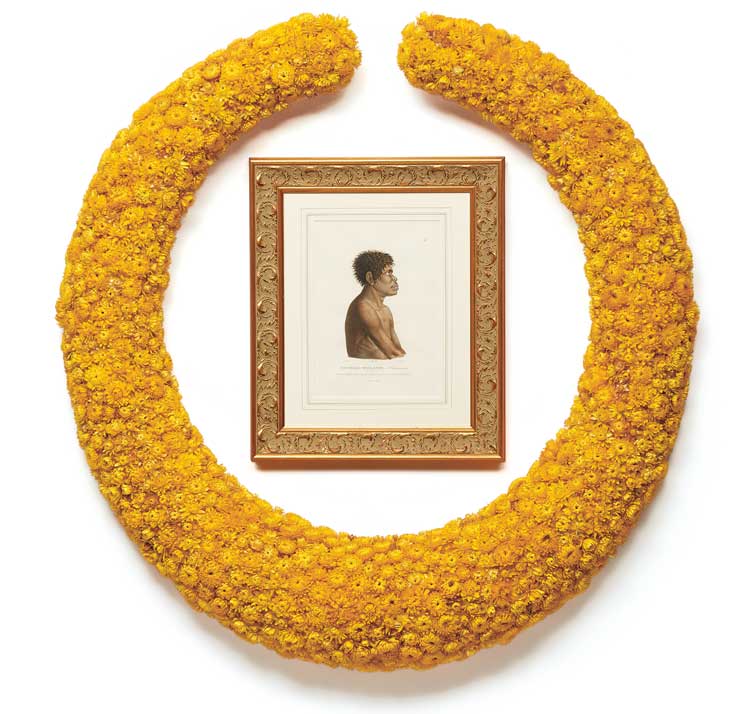
Jonathan Jones. Untitled (remembering Eora: Ourou-Maré), 2021. After Barthélemy Roger, after Nicolas-Martin Petit. Golden everlasting paperdaisy (Xerochrysum bracteatum) flowers on polystyrene foam, polyurethane hardcoat and acrylic paint; framed hand-coloured historical engraving approx. 111.5 × 107 cm. Overall dimensions variable. Photo: Jenni Carter.
Taking as its departure point the vast collections of native Australian plants and animals from Baudin’s expedition that have been housed in institutions in France, along with Aboriginal portraits, Jones and his collaborators have created new objects and music. He uses a range of forms to unpack the complexities of Baudin’s scientific voyage. Through conceptual processing, Jones’s translation of the historic objects enables them to form an important dialogue in the present. A set of wreaths and historical portraits have also been reproduced using Australian materials to replace the colonial features of the early 1800s. Gorgeous yellow everlasting daisies native to Australia and collected by Baudin, happen to be in season at the time of opening in Sydney, and for sale at local markets, their familiarity connecting research-based work to one’s quotidian reality. They create a dramatic block of yellow that is powerful in formal terms. Just as the presentation of plaques of Aboriginal portraits resonated in a present-day symbolism; shape, form and texture are beautifully orchestrated by Jones in an elegant collaborative, community informed exhibition.
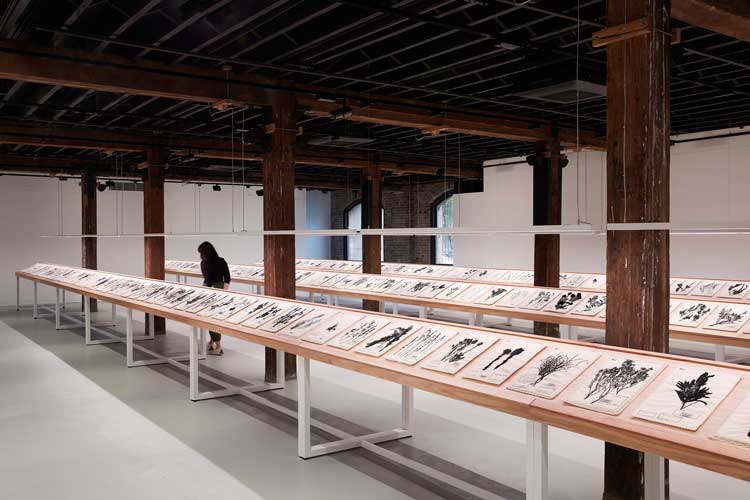
Jonathan Jones. Untitled (transcriptions of country), 2023. Installation view, Artspace, Sydney. Photo: Zan Wimberley.
A significant collaboration in the show includes 308 embroideries, hand-stitched by refugee and migrant collectives in Sydney, of the original scientific plant specimens collected in Australia and housed in France for 200 years. The fact that Jones does not limit himself to working with Aboriginal communities gives the work greater cultural poignancy. The migrants, mainly women and largely from India and Afghanistan, transcribed the Australian plants from the French herbarium collection on to fabric. As a craft form familiar in their own cultures, the process of embroidery helped them to understand more about the plants and animals native to Australia, and Aboriginal elders from Sydney explained their cultural significance to the migrants. The completed embroideries are tactile pieces that relate to the everyday and belong to long traditions. Crucially, as artworks, they are imbued with a positive energy between the project’s participants. One experiences an emotionally charged energy that surpasses the initial sense of conceptual prowess. The innate respect incorporated through collaboration has produced an immediacy that one associates with the directness of drawing. In this way, after 200 years in French institutions, the stored specimens have been revitalised and returned to the community.
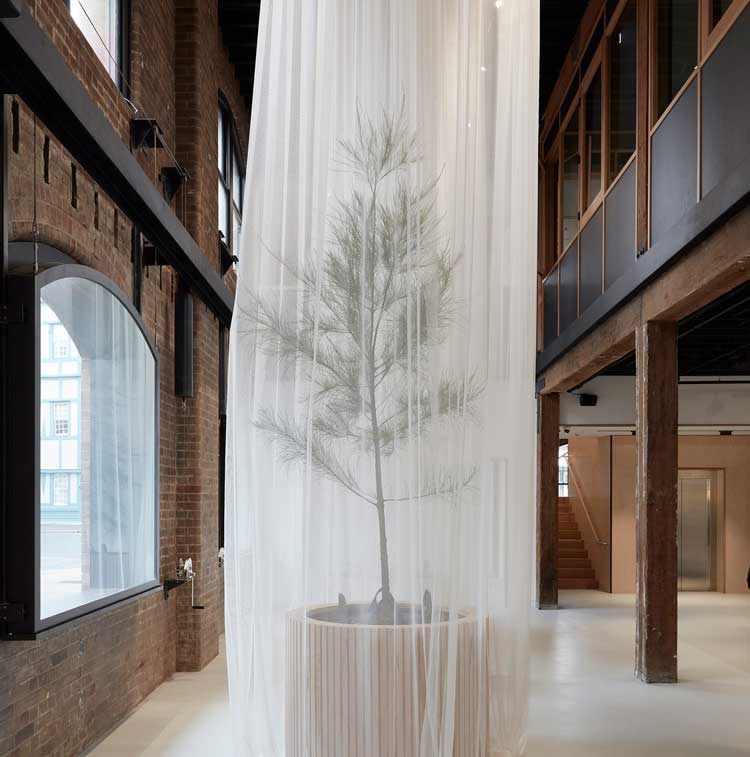
Jonathan Jones. Untitled (transcriptions of country), 2023. Installation view, Artspace, Sydney. Photo: Zan Wimberley.
By empathising with the migrant experience, and in doing so acknowledging the bewilderment and reticence that can be experienced in a new place, Jones extends his own experience of First Nations historic social and cultural relegation. Created before last year’s referendum, Transcriptions of Country highlights the failings and prejudices of the political system to embrace the processes of reconciliation in the broadest contemporary sense. His consummate visual skills and wisdom are in profound contrast to the failure of politicians and those members of Australian society who continue to assert divisive, racist and prejudiced views on the future of a complex nation. The transportation of plant samples and seeds that can prosper in new environments implies growth and understanding in terms of Aboriginal understanding of country. Jones uses collaborative processes to represent respectful sharing of knowledge to connect people and communities.
• A book to accompany the exhibition, Jonathan Jones: Untitled (Transcriptions of Country), co-published by Formist and Artspace, Sydney, is available from Formist, price $43.18 AUD.